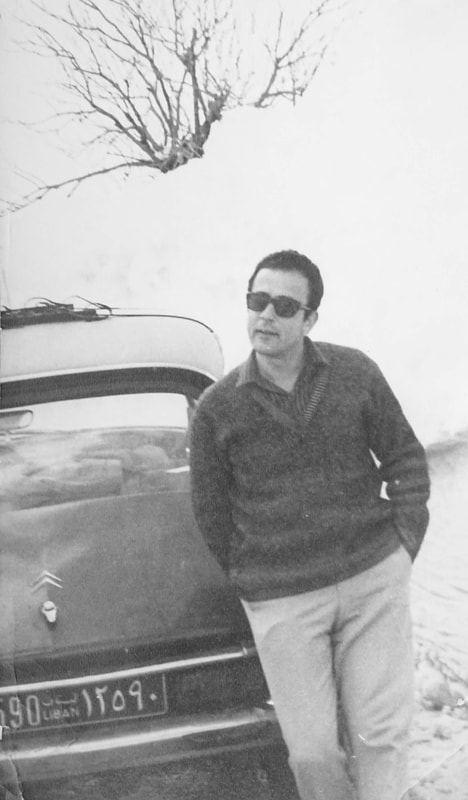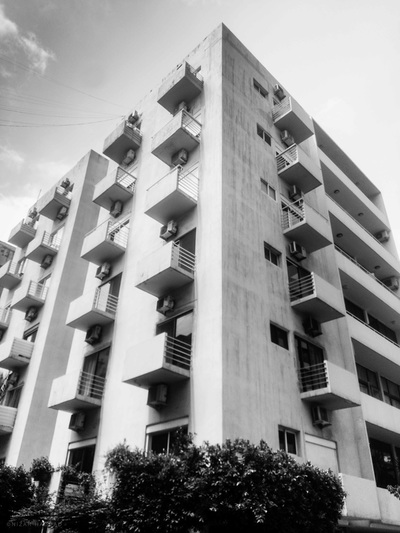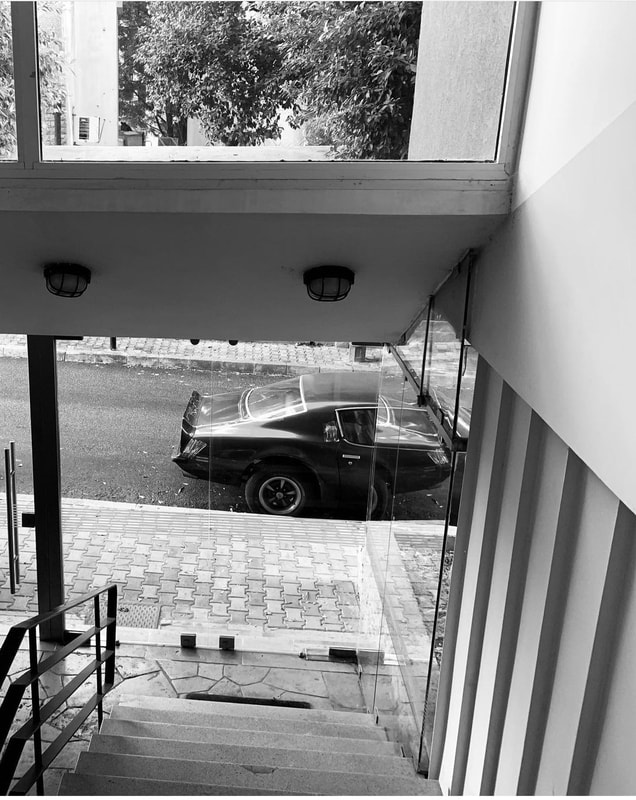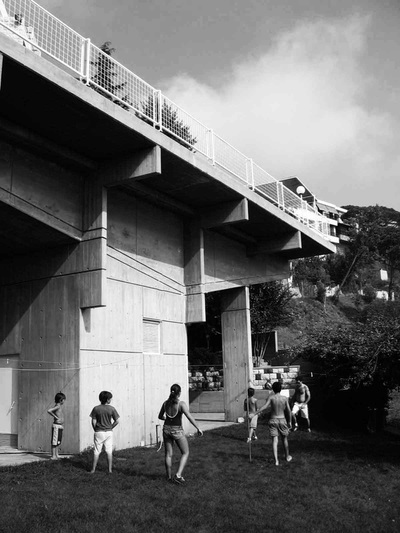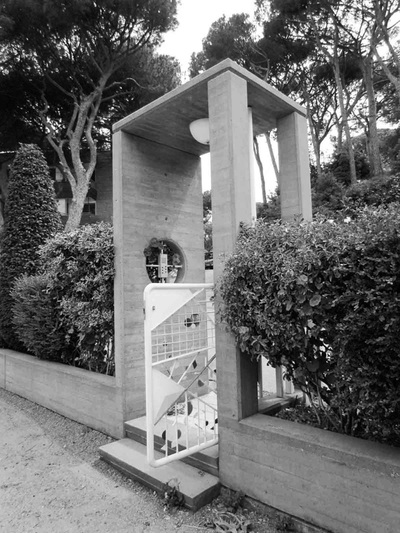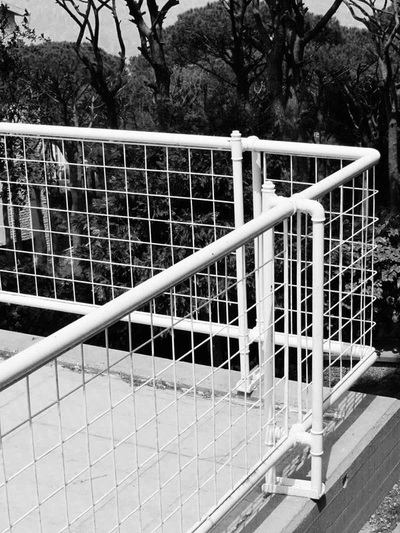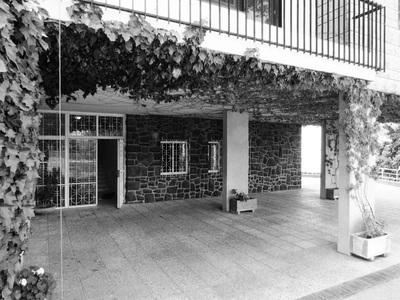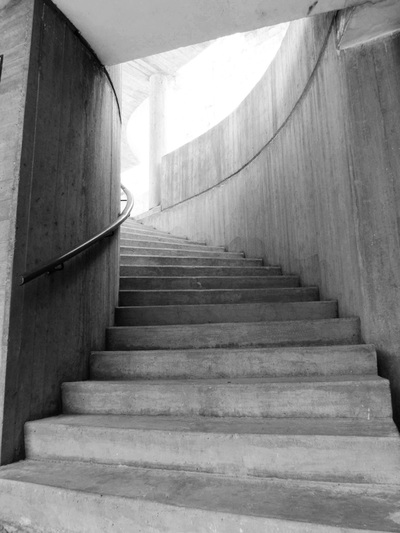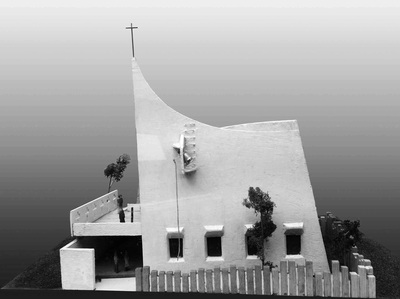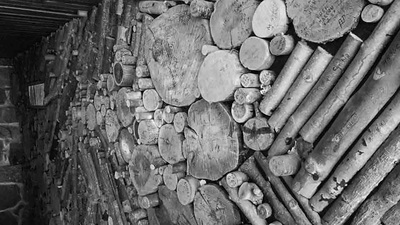Georges Haddad, the father of Nizar Haddad, is a veteran Lebanese architect renowned for being among the pioneers who introduced modern architecture to Lebanon. Georges's legacy serves Nizar as a pedestal with years of inherited experience. Nizar hopes to use the knowledge passed down to him in a bid to bridge the divide between modern man and nature in terms of his designs.
|
Georges Haddad, le père de Nizar Haddad, est un architecte libanais vétéran réputé pour être parmi les pionniers qui ont introduit l’architecture moderne au Liban. L’héritage de Georges sert de piédestal à Nizar avec des années d’expérience héritée. Nizar espère utiliser ce savoir qui lui fut transmis, dans le but de combler le fossé entre l'homme moderne et la nature.
En 1956, Georges Haddad fonda son bureau d'architecture auprès d'autre grands architectes de son époque dont Gregoire Serof, Khalil Khoury, Nicolas Bekhazi. Parmi ses principaux projets citons l’immeuble Spiro Hayek à Achrafieh (1956), les deux immeubles d’habitation Diab à Bhamdoun (1958), le complexe de chalets Al Biyada à Qanat Bakich (1970), le restaurant Chez Michel à Faqra (1995), la Villa Abdel Massih à Beit Mery (1990), l’église Notre Dame du Younbou’ à Bauchrieh (1967), le Restaurant Al Nahr, Baskinta (1970), l’immeuble Echmoun (1975), l’église St Michel à Baskinta (1992) etc. |
SPIRO HAYEK BUILDING
ACHRAFIEH - MOUNT LEBANON
|
Architect Georges Haddad designed the Spiro Hayek building while he was still a student at the Académie Libanaise des Beaux-Arts ( permit signed by an older schoolmate who had just graduated ). The entrance open to the sidewalk, separated from the garage pilotis by a stone wall, the staircase bathed with light, and the cantilevered canopy held by stay-rods, make of this part of the building a distinguished feature, tempering the otherwise rigorous architecture. The prominent balconies of the bedroom facade are inspired by the Bauhaus school, giving the façade a unique look. Patio doors are used for the bedroom balconies, while using bay windows for the living rooms façade, to allow maximum of light.
|
L’architecte Georges Haddad a conçu le bâtiment Spiro Hayek alors qu’il était encore étudiant à l’Académie Libanaise des Beaux-Arts (permis signé par un ancien camarade de classe qui venait d’obtenir son diplôme). l’escalier baigné de lumière, et la voûte en porte-à-faux tenue par des tiges de séjour, font de cette partie du bâtiment une caractéristique distinctive, tempérant l’architecture par ailleurs rigoureuse. Les balcons proéminents de la façade de la chambre sont inspirés de l’école Bauhaus, donnant à la façade un aspect unique. Les portes-fenêtres sont utilisées pour les balcons des chambres, tout en utilisant des baies vitrées pour la façade des salons, pour permettre un maximum de lumière.
|
VILLA JAMIL HADDAD
BASKINTA - MOUNT LEBANON
|
Built in the 1990s, this villa is located in Baskinta, on the flank of a hill. Since the village in question is characerised by a green landscape and the variety of its stones, the architect was able to utilize natural stone in conjunction with concrete, with the intent of ideally integrating the villa into the landscape. The volumes of the edifice are crossed in a simple dynamic composition, and the openings of the dwelling are simple geometric shapes.
|
Construite dans les années 1990, cette villa se situe à Baskinta sur un flanc de montagne. Le village,caractérisé par son paysage vert et la variété de ses roches, a permis à l’architecte d’utilisé la pierre naturelle en mariage avec le béton, dans le but d’intégrer parfaitement la villa dans son paysage. Les volumes jouant sur deux niveaux se croisent dans une dynamique simple avec des formes géométriques pour les ouvertures.
|
VILLA ABDEL MASSIH
BEIT MERI - MOUNT LEBANON
|
In taking into account the sheer beauty of the site, in the green village of Beit Mery, the architect has chosen to utilize large curtain walls from which sea and capital can be seen in the distance. A plain functional architecture which nonetheless retains a dinamic apearence through the use of different materials such as concrete, metalic tubes, and stone in its different forms. The pool, dominant, seems to hover in the air, due to its overhanging stance and aerodynamic shape. It sits attop a concrete mass which serves the purpose of pool technical room. Elsewhere, a decorative water work is created on the terrass, with a concrete basin above which passes a small arched bridge
|
Prenant en compte la beauté du site en ce village vert de Beit Mery, l’architecte a favorisé les larges baies vitrées, surplombant la mer et la capitale. Une architecture sobre, fonctionnelle et en même temps dynamique par l’utilisation de différents matériaux comme le béton, les tubes métalliques et la pierre, elle- même utilisée sous différents aspects. La piscine, dominante, semble flotter en l’air, grâce à sa tenue en porte-à –faux et sa forme aérodynamique. Elle repose sur une masse de béton, servant de chambre technique aux besoins de la piscine. D’autre part, un jeu d’eau est crée sur la terrasse, avec un bassin en béton au-dessus duquel passe un petit pont en arc.
|
SAINT MICHEL MONASTERY
BASKINTA - MOUNT LEBANON
|
The project was to increase the size of an old church, in a modern way... the challenge was accepted by the architect who was able to introduce the spirit of modernity all the while conserving the characteristic elements of byzantine architecture, such as the domed roof. He managed to revisit the dome in a modern style, by utilizing stained glass, thereby introducing light from above. Arches form the periphery of the dome from within, and leaning walls are conceived on both sides of the altar. A large terrass surrounds the church and overlooks the village. It is supported from all sides by flanks of rugged concrete, which allow for people to gather before and after ceremonies, all the while serving as an enclosure. Finally, a large concrete parasol, traversed by a tree, covers part of the sunny terrass. It sits attop a single pillar, thereby freeing the space around it.
|
Il s’agissait d’agrandir une ancienne église, avec modernité…Le défi a été relevé par l’architecte qui a su introduire l’esprit moderne tout en gardant les éléments caractéristiques de l’architecture byzantine, telle la coupole. Il a revisité la coupole dans un style moderne, en utilisant du vitrail, faisant introduire la lumiere par la haut. Des arcs de cercle forment le pourtour de la coupole à l’intérieur, et des murs en courbe sont conçus de part et d’autre de l’autel. Une large terrasse entoure l’église et surplombe une vue sur le village. Elle est bordée de bancs en béton brut, qui permet aux gens de se réunir avant et après la cérémonie, tout en servant aussi de clôture. Enfin, un grand parasol en béton, traversé par un arbre, couvre une partie de la terrasse ensoleillée. Il repose sur un seul poteau, libérant l’espace autour de lui.
|
HOUSING PROJECT
BHAMDOUN - MOUNT LEBANON
|
This housing project, consisting of two blocks with several stories, embraces the slope of its terrain. In order to struggle visually against the slope it's self, the architect conceived of a leaning wall, thereby creating a kind of opposition to the natural slope. A modern minimalistic architecture was exercised in the merging of different materials such as concrete and natural stone. A coordinated composition of concrete shapes, succeeds in defeating the horizontality of the inferior block's terrace. This terrace performs a useful spacial function for the superior block.
|
Ce projet d’habitations, constitué de deux blocs sur différents niveaux, épouse le terrain en pente sur lequel il a été construit. Pour « lutter » visuellement contre cette pente, l’architecte a conçu un mur de pierre coupé en biais, créant une sorte d’opposition à la pente. Une architecture moderne et minimaliste, tout en alliant différent matériaux, comme le béton et la pierre naturelle. Un jeux de formes en béton armé vient casser l’horizontalité de la terrasse du bloc inférieur. Cette terrasse a une fonction d ‘espace utile pour le bloc supérieur
|
OUR LADY OF YOUNBOUU CHURCH
DEKWENEH - MOUNT LEBANON
|
Constructed in 1965, the church is comprised of, in addition to the chapel it's self, reception offices, a waiting room, a small refecory, and a kitchen. The building is of concrete, cladded both outside and inside with white cement plaster. A fence of locally extracted sand stones stood upright, surrounds the chapel and isolates it from surrounding buildings. The construction being primarily a place of prayer, the shape of its frame evokes a vertical momentum directed towards the heavens. The dual notions of the sealed and the opened, dictate the relationship between the religious and the world. The first is ensured by the barrier, the second by the presence of the building amid a residential area. A great simplicity of form and a subtle use of materials, provide this church with a dignity which inspires meditation.
|
Construite en 1965, cette église comprend outre la chapelle, des bureaux de réception, un salon d’attente, un petit réfectoire et une cuisine. La construction est en béton revêtu à l’intérieur comme à l’extérieur d’un enduit de ciment blanc. Une clôture en pierre locale dite “ramlé” d’assise verticale, encercle la chapelle et l’isole des immeubles avoisinants.
Le bâtiment étant avant tout un lieu de prière, sa structure élancée et pure évoque un élan vers le ciel. Isolement et ouverture sont les deux principes de la relation du religieux avec le monde. Le premier est assuré par la barrière, le deuxième par la situation du bâtiment au milieu d’un quartier résidentiel. Une très grande simplicité de formes, une utilisation subtile des matériaux, confèrent à cette église une dignité qui conduit à la méditation. |
RESTAURANT AL NAHR
BASKINTA - MOUNT LEBANON
|
The Architect has encouraged his friend the restaurateur, native from Baskinta, to import and cultivate trout. From there was born the architectural concept which consists primarily of the creation of a vast floating slab above the trout cultivation tanks. Within the slab were perforated several large circular openimgs which permit the visitor to see the trout swimming.
Within the closed section of the restaurant, which is consecrated for winter time, a tree traverses the room by piercing through both floor and ceiling, and extending upwards towards the sky, allowing natural light to penetrate the room, and creating a whimsical atmosphere. A cental conic chimney of hand beaten copper adds to the warm authentic ambiance. |
L’architecte a encouragé son ami restaurateur, natif de Baskinta, d’importer la truite au Liban et à la cultiver. De là est né le concept architectural qui consiste principalement en la création d’une grande dalle de béton flottante au-dessus des bassins de culture des truites. La dalle a été « perforée » de larges ouvertures circulaires permettant aux visiteurs de voir les truites nager.
Dans la partie fermée du restaurant consacrée à l’hiver, un arbre traverse la pièce en perçant le plafond et s’élevant vers le ciel, permettant à la lumière naturelle de pénétrer dans la pièce, créant une atmosphère magique. Une cheminée centrale conique en cuivre frappée à la main vient s’ajouter à cette ambiance chaleureuse et authentique. |
AL BIYADA (for sale)
QANAT BAKICH - BASKINTA - MOUNT LEBANON
|
A complex of 58 chalets has been conceived by Georges Haddad at the end of the sixties at Qanat Bakish, near the ski slopes. The project was interrupted by the war in 1975, leaving an intact concrete structure which was able to withstand the weather and the swings in climate. Typically modern architecture, the shapes are simultaneously minimalist and dynamic, with large bas-reliefs which decorate one façade of each chalet.
|
Un complexe de 58 chalets à été conçu par Georges Haddad à la fin des années soixante à Qanat Bakich, à proximité des pistes de ski. Le projet a été interrompu par la guerre en 1975, laissant une structure en béton intact, qui a su résister au temps et aux différences de climat. Typique de l’architecture moderne, les volumes sont minimalistes et dynamiques à la fois, avec de larges bas-reliefs qui ornent une des façades de chaque chalet.
|

